Horatio McCulloch
| Horatio McCulloch RSA | |
|---|---|
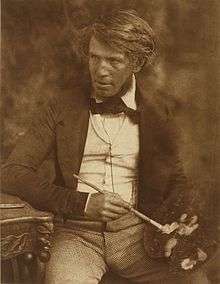 Photographed by Hill & Adamson, 1847 | |
| Born |
November 1805 Glasgow |
| Died |
24 June 1867 Edinburgh |
| Nationality | Scottish |
| Education | John Knox; Daniel Macnee |
| Known for | landscape painting |
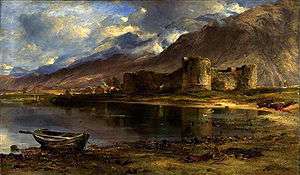
Horatio McCulloch RSA (November 1805 in Glasgow, Scotland – 24 June 1867 in Edinburgh, Scotland), sometimes written M'Culloch, was a Scottish landscape painter.
Life
Horatio McCulloch was trained in the studio of the Glasgow landscape painter John Knox (1778–1845) for about one year alongside Daniel Macnee (1806–1882) and at first earned his living as a decorative painter. He was then engaged at Cumnock, painting the ornamental lids of snuffboxes, and afterwards employed in Edinburgh by William Home Lizars, the engraver, to colour the illustrations in Prideaux John Selby's British Birds and similar works.
After he moved to Edinburgh in 1825, he began painting in the tradition of Alexander Nasmyth. Working unweariedly from nature, he was greatly influenced in his early practice by the watercolours of H. V. Williams. He returned to Glasgow in 1827,and was employed on several large pictures for the decoration of a public hall in St. George's Place, and he did a little as a theatrical scene-painter. About this time by the writings of Sir Walter Scott and the expressive landscape works of John Thomson, friend of Scott's and minister at Duddingston Kirk, Edinburgh. Gradually MacCulloch asserted his individuality, and formed his own style on a close study of nature; his works form an interesting link between the old world of Scottish landscape and the new.
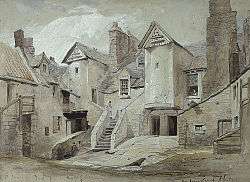
In 1829 McCulloch first figured in the Royal Scottish Academy's exhibition. (He was a regular exhibitor year by year afterwards.)By the early 1830s McCulloch’s exhibits with the Glasgow Dilettanti Society and with the Royal Scottish Academy had begun to attract buyers, notably the newly instituted Association for the Promotion of the Fine Arts in Scotland. A commission from Lord Provost James Lumsden helped established the artist's reputation within Scotland. Commissions from book and print publishers allowed him to concentrate on easel painting.
On his election as full Academician of the Scottish Academy in 1838, McCulloch settled in Edinburgh and soon became a prominent figure in the artistic life of the capital and a prolific contributor to the Royal Scottish Academy exhibitions. At the same time contact with Glasgow was maintained: McCulloch’s favorite sketching grounds were in the west, he exhibited regularly in the city and his most loyal patrons were wealthy Glasgow industrialists such as David Hutcheson (1799–1881), the steamship owner. He seldom exhibited outside Scotland and only once at the Royal Academy, London (1843), but he kept in touch with London artist–friends, John Phillip, David Roberts and John Wilson (1774–1855), through correspondence and visits. His own art collection was evidence of his admiration for 17th-century Dutch painters, for J. M. W. Turner and Richard Wilson and for contemporaries such as Clarkson Stanfield.
During one of his trips to Skye he met his future wife, Marcella McLellan of Gillean, near the township of Tarskavaig. It is known that he had several dogs of the Skye Terrier breed at his Edinburgh home and it is possible that he brought them from Skye with his wife.[1]
McCulloch's pupils included John Smart R.S.A., now best known for his early etchings of golf courses in Scotland.[2] Another was James Alfred Aitken.[3]
McCulloch died on 24 June 1867. He is buried at Warriston Cemetery in Edinburgh. [4] His monument was carved by the Edinburgh sculptor, David Watson Stevenson.
Family
His widow Marcella McLellan, from Sleat on the Isle of Skye, after his death emigrated to Australia. They had no children.
For most of their life they lived at 7 Danube Street, in the Stockbridge area of Edinburgh. His artist friend Kenneth Macleay lived nearby at 16 Carlton Street.[5]
Works
During his lifetime Horatio McCulloch became the best-known and most successful landscape painter in Scotland. His constant aim was to paint the silence of the Highland wilderness where the wild deer roam with the kind of poetic truthfulness he admired in Wordsworth. The accomplished watercolours and broadly painted oil sketches that he produced throughout his career attracted little notice at the time and have remained comparatively unknown.
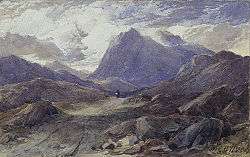
His early works include paintings of Cadzow Forest near Hamilton and grand views of the Clyde. He undertook regular summer sketching tours of the West Highlands, completing the sketches as paintings as back in his studio. These paintings celebrate the romantic scenery of the Scottish Highlands and evoke a magnificent sense of scale, emphasizing the dramatic grandeur. Horatio McCulloch had by his death in 1867 created the essential iconography of the Highlands.
From historical point of view, as the Scottish Lowlands became more urbanised, the distinctiveness of Scotland came to be represented through the Highlands. McCulloch's work was part of a process of distancing the relationship of people to land in the Highlands. In the Victorian period the Highlands to be defined as a wilderness instead of a populated space and many communities were cleared from the land in favor of large sheep farms and sporting interests. In essence, this romantic view of Scottish scenery was brought to a climax by Horatio McCulloch.
Several works by McCulloch were engraved by William Miller and William Forrest, and volume of photographs from his landscapes, with an excellent biographical notice of the artist by Alexander Fraser, R.S.A., was published in Edinburgh in 1872.
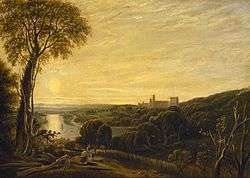
His best known works include:
- Inverlochy Castle (1857)
- Landscape Evening (c1860)
- Glencoe, Argyllshire (1864)
- Loch Katrine (1866)
References
- ↑ http://www.saveourskye.co.uk/history/origins-of-the-skye-terrier/
- ↑ "John Smart Painter Dead". The New York Times. 2 June 1899.
- ↑ H. L. Mallalieu (1986). The Dictionary of British Watercolour Artists up to 1920. Antique Collectors' Club. pp. 13–4. ISBN 1-85149-025-6.
- ↑
 Graves, Robert Edmund (1893). "MacCulloch, Horatio". In Lee, Sidney. Dictionary of National Biography. 35. London: Smith, Elder & Co.
Graves, Robert Edmund (1893). "MacCulloch, Horatio". In Lee, Sidney. Dictionary of National Biography. 35. London: Smith, Elder & Co. - ↑ http://www.oldandnewedinburgh.co.uk/volume5/page90.html
 This article incorporates text from a publication now in the public domain: Chisholm, Hugh, ed. (1911). "MacCulloch, Horatio". Encyclopædia Britannica. 17 (11th ed.). Cambridge University Press. p. 207.
This article incorporates text from a publication now in the public domain: Chisholm, Hugh, ed. (1911). "MacCulloch, Horatio". Encyclopædia Britannica. 17 (11th ed.). Cambridge University Press. p. 207.
Sources
- Sheena Smith (1988). Horatio McCulloch 1805-1867. Glasgow Museums and Art Galleries. ISBN 0-902752-35-9
- Murdo MacDonald (2000). Scottish Art. Thames & Hudson, New York, NY, pp 104–106. ISBN 0-500-20333-4
- Alexander Fraser (1872). The Life and Works of Horatio McCulloch.
- John Morrison (2003). Painting the Nation: Identity and Nationalism in Scottish Painting, 1800-1920. Edinburgh University Press. ISBN 0-7486-1602-0
- David Irwin, Francina Irwin (1975). Scottish Painters: at Home and Abroad 1700-1900. Faber and Faber, London, pp 353–357 ISBN 0-571-08822-8
External links
| Wikimedia Commons has media related to Horatio McCulloch. |
- Photo of Horatio MacCulloch
- Haratio Mcculloch's works in National Galleries of Scotland
- Exhibition at Tate, Highlands and Glens Land of the Mountain and the Flood